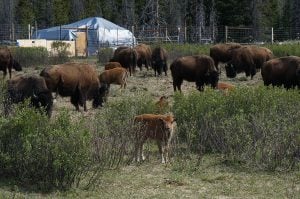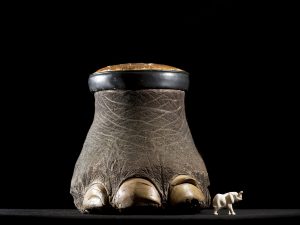
Places
Back where they belong
Nearly wiped out in Alberta in the 1800s, plains bison are making a historic return to Banff National Park
- 2148 words
- 9 minutes
Wildlife
Plus: "bees of the sea" are pollinating underwater plants, snow geese are bouncing back hard, Greenland sharks are appearing in unlikely waters and birds are proving smarter than ever

Three cheers for three recent additions at the Toronto Zoo! The popular additions to the zoo menagerie are wood bison calves — two female and one male — that were born in late June. Two of the calves were born from an innovative reproductive technique that allows scientists to generate more females. It’s the first-time sex-sorted artificial insemination has been used in wood bison.
This technology can help increase the number of female wood bison both in captivity and in free-roaming herds and is an important step forward for the long-term sustainability of bison conservation herds. Ongoing diseases in wild populations continue to threaten this species.
“The primary reason of this phase of the project is to produce non-diseased bison that one day can be reintroduced into the wild,” says Dr. Gabriela Mastromonaco, senior director of wildlife science at the Toronto Zoo.
The little ones are healthy and active, chasing each other and exploring their surroundings. Curious by nature, they like to investigate all features of their landscape.

In the same way that bees, butterflies and hummingbirds play a vital role in the pollination of flowering plants on land, scientists have discovered that small, bug-like crustaceans work hard to help the propagation of algae underwater.
While Idotea balthica specifically pollinate red seaweed, found growing in tidal pools, the findings published in the journal Science suggest that animal-mediated underwater pollination may be widespread and perhaps even first evolved underwater rather than on land. While fertilization with the help of animals was believed to have emerged among plants when they moved ashore 450 million years ago, red seaweed arose over 800 million years ago meaning their animal-based fertilization may predate that of pollination on land.
Just as with bees and plants on land, the benefits may well be mutual. The findings suggest the crustaceans use the algae as a safe place to shelter as well as a source of food in the form of the single-celled algae that grows on red seaweed.

The snow goose, a conservation success story, is beginning to worry scientists for the impact its rapidly-growing population is having on fragile ecosystems.
In the early 1900s, only 3,000 snow geese were estimated to be left. In recent years, a population explosion has seen their numbers top 15 million. This growth can be attributed to two factors that cause harm to most species: climate change and habitat loss. Melting snow in the geese’s Arctic breeding grounds is providing more food and nesting sites, while, to the south, destruction of marshland is pushing the birds into farmers’ fields, where a diet of grain and corn is keeping them well-fed.
While once something to celebrate, a ballooning snow goose population can be problematic. Banks Island, in the Beaufort Sea, and the Fraser River Estuary, in southern B.C., are both expected to see the arrival of more migrating snow geese this year than their ecosystems can handle.
A possible solution is increasing the snow goose hunt in affected areas. However, this won’t work in areas where there are too few hunters and too many geese. The snow goose represents a strange consequence of warming temperatures, a species thriving despite, or because of, changing environments.

For the first time, a Greenland shark — typically found in freezing Arctic waters at depths of up to 2,000 metres — has been found in Caribbean waters.
Spotted by Devanshi Kasana, a doctoral candidate at Florida International University, while out tagging tiger sharks with a crew of Belize fishermen, the surprising discovery in the warm, shallow waters of Belize’s coral reefs suggests this mysterious species is more pervasive than previously thought.
Kasana and her crew made the discovery after hauling up a longline they’d dropped deep into the waters at the edge of Glover’s Reef. The goal was to catch and tag tiger sharks to study their movement and ecology.
Kasana initially thought they’d caught a six gill shark, and it took a quick call with her Ph.D. advisor, Demian Chapman, to identify it as a Greenland shark. As the world’s longest-living vertebrate, Greenland sharks can live upwards of 400 years and are the largest fish in the Arctic Ocean. It has previously been theorized that sleeper sharks, such as the Greenland shark, could occur globally in waters deep enough to keep them sufficiently cool — as well as out of sight of scientists.

Mammals like chimpanzees, elephants and dolphins are widely considered the most intelligent members of the animal kingdom after humans. But maybe it’s time to look beyond the bird-brain stereotype and add a few of our feathered friends to the smart list, according to a recent study published in Nature Ecology & Evolution, with contributions from McGill University researchers.
Researchers used a new technique to estimate the numbers of neurons present in the brain area in birds known as the pallium. The pallium is the equivalent of the human cerebral cortex, which is the part of the brain that is involved in many complex processes — think memory, learning and problem-solving.
When researchers combined their neuron findings with other behavioural information, they discovered that the bird species with a higher number of neurons in the pallium were likely to be the most innovative. Time spent in the nest may also influence a bird’s intelligence, as the brain can grow more pallial neurons over a longer development period.
Are you passionate about Canadian geography?
You can support Canadian Geographic in 3 ways:

Places
Nearly wiped out in Alberta in the 1800s, plains bison are making a historic return to Banff National Park

Wildlife
An estimated annual $175-billion business, the illegal trade in wildlife is the world’s fourth-largest criminal enterprise. It stands to radically alter the animal kingdom.

Wildlife
Plus: Rapidly evolving cod, surprise science, two new bird monitoring stations and how to protect clams against extreme heat

Environment
For the first time ever, a Canadian zoo has successfully produced a calf from an embryo sent from another province. Here's what that could mean for species conservation.